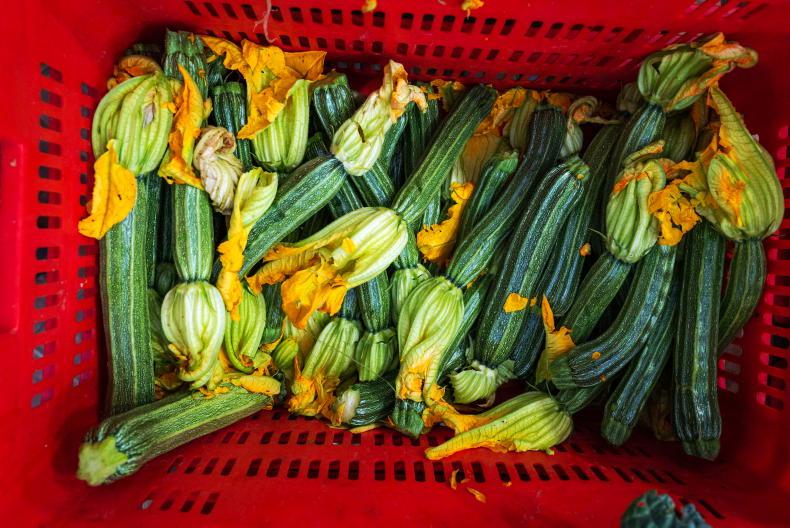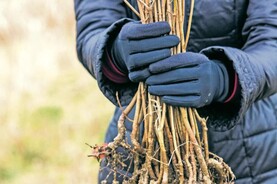August alludes to abundance, that time when all the drudgery of broad-forking, digging, mulching, weeding and the stressful struggle with slugs is finally vindicated.
But as always in a kitchen garden, there is no time to rest on your laurels.
As crops are harvested and cleared, ensure to maximise your space with successful sowings of salads, spring onions, spring cabbage and spinach and by planting out those seedlings sown last month.
Spicy salads
Oriental salads make a great over-winter crop for even the smallest of spaces and respond very well to August sowings.
Stalwarts include mustards, mibuna and mizuna with mixed packs of ‘spicy’ or ‘Asian’ salad leaf packs often giving the best bang for buck.
Leaves are most tender when grown under-cover, but equally they are ideal for maximising garden space after early crops of potatoes, peas or beetroot are cleared. The leaves are cut and come again and can be harvested at virtually any size, but timing is everything.
For novice seed savers, certain self-pollinated crops such as peas and beans are particularly easy
For outdoor cropping, sow in-situ or transplant in August. Being mostly brassicas, oriental salads are susceptible to all pests associated with this family but flea beetles are the most cumbersome, especially in outdoor crops.
These are tiny shiny beetles that jump from plant to plant, nibbling small shotgun holes in leaves.
Later sowings are less susceptible but it pays to cover plants with environmesh. Sowings can be made up to mid-September for indoor cropping but will need to be sown outdoors now.
A direct sown bed of oriental salads outside in early-mid August could possibly continue to yield robust leaves right up until late November.
Blight alert
If you planted first and second early potatoes, you will be tucking into your freshly dug, flavoursome spuds now.
Main crops come into their own next month so it is important to stay vigilant for signs of late blight, a well-known disease caused by the fungus-like organism phytophthora infestans.
Characterised by dark-brown, water-soaked lesions on leaves and stems, late blight can swiftly devastate a crop, particularly in the wet conditions we know all too well.
Selecting blight-resistant potato varieties is always recommended but will not always safeguard, so if blight does strike, early detection is key.
Promptly remove and destroy affected foliage to prevent its spread, leaving tubers in the ground to continue growing, for harvesting next month.
Reap what you sow
Homegrown vegetables stride streets ahead of their shop-bought counterparts that unfortunately, are mostly selected for easy packaging, storage and display. Often they are far removed from their original parent plant.

Courgette harvest. \ iStock
For example, beetroot is sold leafless and usually peeled and pickled; turnips are sold without their tops; brussels sprouts are removed from their stem and courgettes come deprived of their flowers.
Home-growing allows you to become accustomed to plants as a whole and thus, benefit from all their edible parts. After all, it takes effort to grow your own food so it makes sense to use everything you grow to its full potential.
My advice is to harvest plants as soon as crops are ready in order to enjoy fresh and tender returns. Vegetables are not monuments, they are grown to be harvested, consumed and enjoyed.
Some crops, such as white turnips and kohlrabi, will lose flavour and become tough and stringy if not used at the appropriate time.
Others such as peas, beans, courgettes and certain herbs will actually be encouraged to yield more by continual harvesting – as the more you pick, the more the plants produce.
Seed saving
While today’s seed catalogues are ubiquitous, seed saving is a traditional skill that every home gardener should cultivate. It is widely agreed that home saved seed has the most vigour with seeds being well adapted to local climate conditions.

Seed Saving. \ iStock
Saving your own seed will help reduce input costs while enhancing self-sufficiency and sustainability in your garden. It’s what our ancestors did, so if you want to try saving some of your own, now is a good time to start.
For novice seed savers, certain self-pollinated crops such as peas and beans are particularly easy. Collect seeds from robust, open-pollinated plants by simply allowing the pods to dry on the plant.
Harvest on a dry day, shell and spread the seeds out indoors to further dry if necessary. Remove any that are damaged or discoloured before storing for sowing and sharing next year.
Annual flowers such as calendula, Nigella and sweet peas are also an excellent seed saving entry point.
Down tools
August is the perfect time for being inspired by other people’s gardens and the ideal time for mingling with like-minded gardeners so make sure to down tools and get out and about to help spark new ideas for next year.
Your next year’s kitchen garden will thank you, as you are sure to come back brimming with ideas, a refreshed spirit and maybe even a handful of seeds.
August alludes to abundance, that time when all the drudgery of broad-forking, digging, mulching, weeding and the stressful struggle with slugs is finally vindicated.
But as always in a kitchen garden, there is no time to rest on your laurels.
As crops are harvested and cleared, ensure to maximise your space with successful sowings of salads, spring onions, spring cabbage and spinach and by planting out those seedlings sown last month.
Spicy salads
Oriental salads make a great over-winter crop for even the smallest of spaces and respond very well to August sowings.
Stalwarts include mustards, mibuna and mizuna with mixed packs of ‘spicy’ or ‘Asian’ salad leaf packs often giving the best bang for buck.
Leaves are most tender when grown under-cover, but equally they are ideal for maximising garden space after early crops of potatoes, peas or beetroot are cleared. The leaves are cut and come again and can be harvested at virtually any size, but timing is everything.
For novice seed savers, certain self-pollinated crops such as peas and beans are particularly easy
For outdoor cropping, sow in-situ or transplant in August. Being mostly brassicas, oriental salads are susceptible to all pests associated with this family but flea beetles are the most cumbersome, especially in outdoor crops.
These are tiny shiny beetles that jump from plant to plant, nibbling small shotgun holes in leaves.
Later sowings are less susceptible but it pays to cover plants with environmesh. Sowings can be made up to mid-September for indoor cropping but will need to be sown outdoors now.
A direct sown bed of oriental salads outside in early-mid August could possibly continue to yield robust leaves right up until late November.
Blight alert
If you planted first and second early potatoes, you will be tucking into your freshly dug, flavoursome spuds now.
Main crops come into their own next month so it is important to stay vigilant for signs of late blight, a well-known disease caused by the fungus-like organism phytophthora infestans.
Characterised by dark-brown, water-soaked lesions on leaves and stems, late blight can swiftly devastate a crop, particularly in the wet conditions we know all too well.
Selecting blight-resistant potato varieties is always recommended but will not always safeguard, so if blight does strike, early detection is key.
Promptly remove and destroy affected foliage to prevent its spread, leaving tubers in the ground to continue growing, for harvesting next month.
Reap what you sow
Homegrown vegetables stride streets ahead of their shop-bought counterparts that unfortunately, are mostly selected for easy packaging, storage and display. Often they are far removed from their original parent plant.

Courgette harvest. \ iStock
For example, beetroot is sold leafless and usually peeled and pickled; turnips are sold without their tops; brussels sprouts are removed from their stem and courgettes come deprived of their flowers.
Home-growing allows you to become accustomed to plants as a whole and thus, benefit from all their edible parts. After all, it takes effort to grow your own food so it makes sense to use everything you grow to its full potential.
My advice is to harvest plants as soon as crops are ready in order to enjoy fresh and tender returns. Vegetables are not monuments, they are grown to be harvested, consumed and enjoyed.
Some crops, such as white turnips and kohlrabi, will lose flavour and become tough and stringy if not used at the appropriate time.
Others such as peas, beans, courgettes and certain herbs will actually be encouraged to yield more by continual harvesting – as the more you pick, the more the plants produce.
Seed saving
While today’s seed catalogues are ubiquitous, seed saving is a traditional skill that every home gardener should cultivate. It is widely agreed that home saved seed has the most vigour with seeds being well adapted to local climate conditions.

Seed Saving. \ iStock
Saving your own seed will help reduce input costs while enhancing self-sufficiency and sustainability in your garden. It’s what our ancestors did, so if you want to try saving some of your own, now is a good time to start.
For novice seed savers, certain self-pollinated crops such as peas and beans are particularly easy. Collect seeds from robust, open-pollinated plants by simply allowing the pods to dry on the plant.
Harvest on a dry day, shell and spread the seeds out indoors to further dry if necessary. Remove any that are damaged or discoloured before storing for sowing and sharing next year.
Annual flowers such as calendula, Nigella and sweet peas are also an excellent seed saving entry point.
Down tools
August is the perfect time for being inspired by other people’s gardens and the ideal time for mingling with like-minded gardeners so make sure to down tools and get out and about to help spark new ideas for next year.
Your next year’s kitchen garden will thank you, as you are sure to come back brimming with ideas, a refreshed spirit and maybe even a handful of seeds.








 This is a subscriber-only article
This is a subscriber-only article









SHARING OPTIONS: